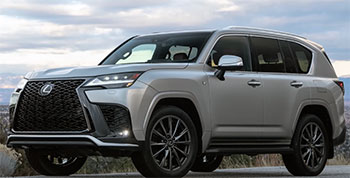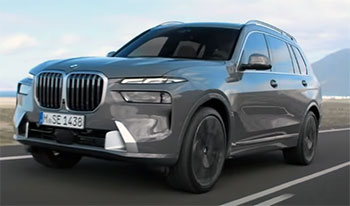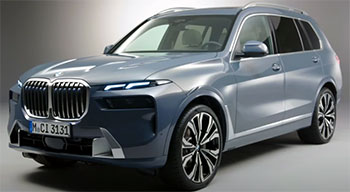I’m in the market for a luxury three-row SUV, and the BMW X7 and Lexus TX have caught my eye. Both promise to blend opulence, performance, and family-friendly practicality, but which one truly delivers? In this article, I’ll share my first-hand experience exploring these vehicles, weighing their strengths and weaknesses to help you decide which suits your lifestyle.
From driving dynamics to interior comfort, I’ll break it all down with a clear, engaging perspective, so you can make an informed choice for your next big purchase.
Comparison Table: BMW X7 vs. Lexus TX
| Feature | BMW X7 (2025 xDrive40i) | Lexus TX (2024 TX 350) |
|---|---|---|
| Starting MSRP | $85,475 | $56,490 |
| Engine | 3.0L Turbo Inline-6, 375 hp | 2.4L Turbo Inline-4, 275 hp |
| Fuel Economy (City/Hwy) | 20/24 MPG | 21/27 MPG |
| Cargo Space (Seats Up) | 12.8 cu. ft. | 20.2 cu. ft. |
| Max Cargo Space | 90.4 cu. ft. | 90.4 cu. ft. |
| Towing Capacity | 7,500 lbs | 5,000 lbs |
| Seating Capacity | 7 (6 with captain’s chairs) | 7 (6 with captain’s chairs) |
| Infotainment Screen | 14.9-inch Curved Display | 14-inch Touchscreen |
| Warranty | 4 years/50,000 miles | 6 years/70,000 miles (powertrain) |
| Key Safety Features | Cross Traffic Warning with Braking | Height-adjustable front seat belts |
My First Impressions: Stepping Into Luxury
When I first laid eyes on the BMW X7, its sheer presence floored me. It’s massive, with a bold kidney grille that screams confidence. The Lexus TX, on the other hand, has a sleeker, more refined look with its spindle grille and sharp headlights.
I felt like the X7 was saying, “I’m here to dominate,” while the TX whispered, “I’m elegant but ready for action.” Both are head-turners, but the X7’s aggressive stance appeals to those who want to make a statement, whereas the TX feels more approachable, almost understated in its luxury.
Driving Experience: Power Meets Precision

I took the BMW X7 xDrive40i for a spin first. Its 3.0-liter turbocharged inline-6 engine, pumping out 375 horsepower, felt like a beast tamed by precision engineering.
The acceleration was smooth yet forceful, and the eight-speed automatic transmission shifted seamlessly.
What surprised me most was how this giant handled corners. Thanks to its air suspension and optional active suspension system, the X7 felt planted, almost defying its size.
I switched to Sport mode, and the ride tightened up, making twisty roads a thrill. On the highway, it glided like a flagship sedan, with minimal road noise—only a faint whisper of wind at 80 mph.
The Lexus TX 350, with its 2.4-liter turbo four-cylinder producing 275 horsepower, didn’t pack the same punch. It’s peppy enough for daily driving, but I noticed the engine sounded strained under hard acceleration. The TX’s ride, supported by coil springs, was comfortable but less dynamic than the X7’s. It leaned more in corners, and while the eight-speed automatic was smooth, it didn’t have the X7’s razor-sharp responsiveness.
However, the TX’s lighter weight—about 600 to 1,000 pounds less than the X7—made it feel nimble in city traffic. For long drives, the TX’s cabin was quieter, thanks to active noise cancellation on higher trims, which I appreciated during a test drive on a noisy freeway.
Performance Pros and Cons
BMW X7
Pros:
- Powerful 375-hp engine with smooth delivery.
- Air suspension provides a plush, adjustable ride.
- Sport mode transforms handling, making it surprisingly agile.
- Towing capacity up to 7,500 pounds, ideal for heavy loads.
Cons:
- Fuel economy (20/24 MPG) lags slightly behind the TX.
- Heavier weight can feel cumbersome in tight spaces.
Lexus TX
Pros:
- Better fuel economy (21/27 MPG) saves at the pump.
- Lighter weight enhances city maneuverability.
- Hybrid options (TX 500h/550h+) boost efficiency.
Cons:
- Base engine feels underpowered compared to X7.
- Coil suspension lacks the X7’s refinement in handling.
- Limited towing capacity (5,000 pounds) for a three-row SUV.
Interior: Where Comfort Meets Craftsmanship

Sliding into the BMW X7’s cabin felt like entering a high-tech lounge. The 14.9-inch curved display, paired with BMW’s iDrive 8.5, was a tech lover’s dream.
Everything from navigation to climate controls was intuitive, though I missed physical buttons for quick adjustments.
The merino leather seats were buttery soft, and the optional massage function was a game-changer on long drives.
The panoramic sky lounge roof added an airy feel, but the third row was tight for adults—better suited for kids. Cargo space behind the third row (12.8 cu. ft.) was adequate, but folding the second row unlocked a cavernous 90.4 cu. ft.
The Lexus TX’s interior, while plush, leaned more toward practicality. Its 14-inch touchscreen was crisp and user-friendly, with physical knobs for volume and climate—points for accessibility. The seats were comfy, with more front and second-row legroom (41.7 and 39.5 inches vs. the X7’s 39.8 and 37.6 inches).
The TX’s cargo space behind the third row (20.2 cu. ft.) was a standout, making it easier to haul gear without folding seats. However, the materials, while high-quality, didn’t match the X7’s premium feel. The TX’s third row was slightly roomier, but still not ideal for adults on long trips.
Interior Pros and Cons
BMW X7
Pros:
- Luxurious materials, like merino leather and glass controls.
- High-tech curved display with customizable interface.
- Spacious first and second rows with optional massage seats.
- Panoramic sky lounge roof enhances cabin ambiance.
Cons:
- Third row is cramped for adults.
- Less cargo space behind third row (12.8 cu. ft.).
- Touchscreen-heavy controls can be distracting.
Lexus TX
Pros:
- Roomier front and second-row legroom.
- Generous cargo space behind third row (20.2 cu. ft.).
- User-friendly infotainment with physical knobs.
- Three-zone climate control standard across trims.
Cons:
- Materials feel less premium than X7’s.
- Third row still tight for adults.
- No active suspension limits ride customization.
Safety and Technology: Keeping You Secure

Both SUVs come loaded with safety features, but they approach it differently.
The X7’s standard Cross Traffic Warning with Braking impressed me during a test drive when it automatically braked to avoid a car I didn’t see while reversing.
It also has regenerative brakes across all trims, boosting efficiency.
However, it lacks height-adjustable front seat belts, which the TX offers for better fit and comfort.
The TX also has a back-seat reminder to prevent leaving kids behind—a feature the X7 doesn’t have. Both include frontal airbags, side-impact airbags, lane departure warnings, and blind-spot monitoring.
On the tech front, the X7’s iDrive 8.5 feels futuristic, with over-the-air updates and a slick interface. The TX’s infotainment is more straightforward, with wireless Apple CarPlay and Android Auto working flawlessly.
The TX’s hybrid trims add active noise cancellation, which made my freeway drive noticeably quieter. However, the X7’s optional five-zone climate control and heated armrests edged out the TX’s three-zone system for luxury.
Read More: My Thoughts On Acura MDX Vs. Lexus GX
Safety and Technology Pros and Cons
BMW X7
Pros:
- Cross Traffic Warning with Braking enhances safety.
- Regenerative brakes improve efficiency across trims.
- Advanced iDrive 8.5 with over-the-air updates.
- Optional five-zone climate control for ultimate comfort.
Cons:
- No height-adjustable front seat belts.
- No back-seat reminder for families.
- Touchscreen reliance can be cumbersome.
Lexus TX
Pros:
- Height-adjustable seat belts for better fit.
- Back-seat reminder for family safety.
- Intuitive infotainment with physical controls.
- Active noise cancellation on hybrid trims.
Cons:
- Parking Support Brake limited to higher trims.
- Regenerative brakes only on hybrid models.
- Less advanced tech compared to X7’s iDrive.
Cost and Value: What You Get for Your Money
Price is where the Lexus TX shines. Starting at $56,490, it’s nearly $30,000 less than the X7’s $85,475 base price. Even the TX 500h hybrid, with 366 horsepower, starts around $69,000—still a bargain compared to the X7. The TX’s powertrain warranty (6 years/70,000 miles) outlasts the X7’s (4 years/50,000 miles), and its EPA rating of 7/10 for emissions beats the X7’s 5-7/10. For budget-conscious buyers, the TX offers luxury without breaking the bank.
The X7, however, justifies its price with superior performance and premium features. Its air suspension, larger fuel tank (21.9 gallons vs. TX’s 17.8), and higher towing capacity make it a versatile choice. Maintenance costs may be higher—some owners estimate $3,000-$5,000 more over 3-5 years—but BMW includes free maintenance for 4 years/50,000 miles, easing the sting. The X7’s 43% more dealerships also mean easier service access.
Cost and Value Pros and Cons
BMW X7
Pros:
- Free maintenance for 4 years/50,000 miles.
- Higher towing capacity and larger fuel tank.
- More dealerships for convenient service.
- Premium features justify the price for luxury seekers.
Cons:
- Higher starting MSRP ($85,475).
- Potentially higher maintenance costs long-term.
- Slightly lower EPA emissions rating.
Lexus TX
Pros:
- Lower starting price ($56,490).
- Longer powertrain warranty (6 years/70,000 miles).
- Better fuel economy and EPA rating.
- Hybrid options offer efficiency and power.
Cons:
- Fewer dealerships for service.
- Lower towing capacity limits utility.
- Less premium interior materials.
My Test Drive Tales: Real-World Insights
During my X7 test drive, I took it on a winding road in upstate New York. The air suspension soaked up bumps, and the adjustable ride height made entering and exiting a breeze. I loaded up the cargo area with camping gear, and while the space behind the third row was tight, folding the seats revealed ample room. The X7 felt like a luxury liner, but its heft was noticeable in tight parking lots.
The TX, tested in city traffic, was easier to maneuver. I packed groceries and sports equipment behind the third row with room to spare. The hybrid TX 500h I drove later felt peppier, and the fuel savings were noticeable after a week. However, the TX’s engine noise under acceleration was a letdown compared to the X7’s refined growl.
Reliability and Ownership: Long-Term Considerations
Lexus has a reputation for bulletproof reliability, and the TX’s longer warranty backs that up. Online forums mention fewer issues with Lexus SUVs compared to BMWs, though newer X7 models have improved. One Reddit user noted their X7 required only an oil change in the first year, but tires were pricey. The TX’s hybrid options may appeal to eco-conscious buyers, but the X7’s diesel (Europe-only) and mild-hybrid systems offer efficiency without sacrificing power.
Which One’s for You?
After spending time with both, I lean toward the X7 for its driving dynamics and luxurious interior. It’s the choice if you crave performance and don’t mind the price. The TX, however, is a value champion, offering family-friendly space and efficiency. If budget and reliability are your priorities, the TX is hard to beat. Test drive both—you’ll know which feels like home.
Read More: My Thoughts On Acura MDX Vs. Volvo XC90
Frequently Asked Questions (FAQ)
The Lexus TX is the primary competitor to the BMW X7, offering a three-row luxury SUV with similar seating and cargo capacity.
The Lexus TX is comparable to the BMW X7, Mercedes GLS, and Lincoln Aviator, focusing on luxury and family-friendly features.
The BMW X7 is larger, with 203.3 inches in length and 90.4 cu. ft. max cargo space, compared to the Volvo XC90’s 194.9 inches and 85.7 cu. ft.
The BMW X7 is comparable to the Lexus TX, Mercedes GLS, Audi Q7, and Lincoln Aviator in the luxury three-row SUV segment.
Conclusion: Your Road, Your Choice
You’re now armed with the full scoop on the BMW X7 and Lexus TX. I’ve shared my journey testing these SUVs, from their thrilling drives to their luxurious cabins. The X7 offers unmatched performance and premium flair, while the TX delivers value and practicality. Think about what matters most—power or savings, flash or function—and take a test drive. You’ll find the one that fits your life like a glove.

